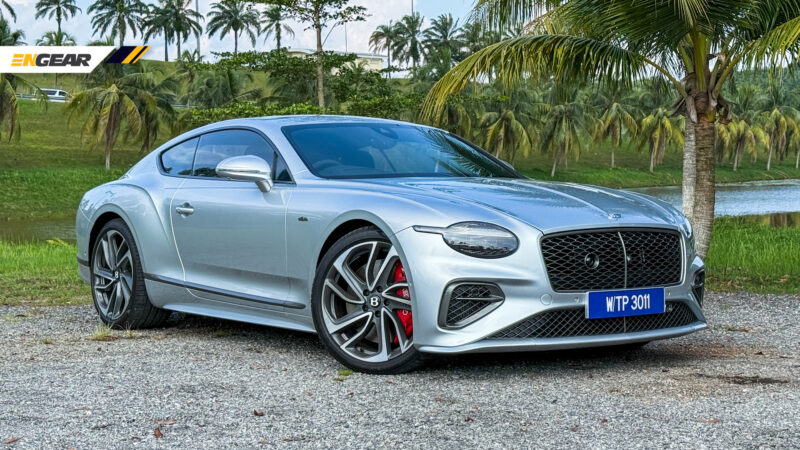Bentley Kuala Lumpur recently celebrated the arrival of the most powerful grand tourer (GT) model ever produced, the Bentley Continental GT Speed.
This fourth generation Continental GT Speed is powered by a V8 plug-in hybrid (PHEV) ‘Ultra Performance Hybrid’ engine that delivers a total power of 782 PS and torque of 1,000 Nm.
The twin-turbo V8 engine itself is capable of producing 600 PS and 800 Nm, paired with an electric motor generating 190 PS/450 Nm, which is integrated into the transmission housing to reduce turbo lag.
Overall, this PHEV setup provides a 19 percent increase in power and an 11 percent higher torque compared to the W12 engine-equipped Continental GT Speed.
There is no need for cylinder deactivation anymore, as the hybrid system in the Continental GT Speed can completely stop the engine’s operation when the electric motor is running.
The power is transmitted to the wheels via an eight-speed dual-clutch transmission, assisted by an electronically controlled limited-slip differential (eLSD).
Consequently, the acceleration from 0 to 100 km/h is achieved in just 3.2 seconds before reaching a top speed of 335 km/h.
The 25.9 kWh battery pack allows this GT to be driven in zero-emission mode for up to 80 km at speeds of up to 140 km/h.
The Continental GT Speed also comes equipped with an active all-wheel drive system, all-wheel steering, torque vectoring, Bentley Dynamic Ride, and new generation ESC control software.
To ensure this GT machine stops excellently, Bentley has fitted a braking system consisting of a 10-piston caliper and 420 mm rotors at the front, followed by a four-piston caliper and 380 mm rotors at the rear.
There is also an option to equip a carbon-silicon-carbide braking system with 440 mm rotors at the front and 410 mm at the rear.
This fourth generation Bentley Continental GT is the first Bentley model to feature a single headlight setup, replacing the previous dual round light configuration.
The LED matrix headlight unit features 120 individual LEDs that can be digitally controlled to maximize lighting.
Meanwhile, the rear lights have a three-dimensional diamond pattern that creates a molten lava effect when lit.
All four wheel arch corners are adorned with newly designed 22-inch rims inspired by tigers.
The cockpit of the Bentley Continental GT Speed provides seats that can be adjusted in 20 ways, ensuring great comfort for long journeys, a cluster of function buttons for HVAC on the center console, and the presence of an analog clock at the center of the air conditioning vents.
For the driver, a digital cluster screen is provided, while the center features the Bentley Rotating Display that offers three different sides: a 12.3-inch infotainment screen, three analog dials, or a blank panel if you prefer an uninterrupted driving experience.
Three audio system options are offered for the Continental GT:
- Standard 650W with 10 speakers
- Bang & Olufsen 1,500W with 16 speakers and illuminated grilles
- Naim 2,200W, 18 speakers, Active Bass Transducers, and up to eight modes available for audiophiles
Cabin comfort is enhanced by laminated acoustic glass, which offers up to 9 dB quieter performance compared to non-acoustic glass.
This Bentley GT is also equipped with support for wireless Apple CarPlay and Android Auto, over-the-air (OTA) updates, ambient lighting systems, and Intelligent Park Assist features.
For the Malaysian market, the Bentley Continental GT Speed is priced from RM3,120,000 excluding insurance, road tax, and registration, as well as personal customization options.
